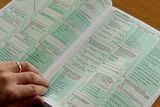Census 2022: Drop in Catholicism, more Irish speakers and population above 5m – everything you need to know


The Central Statistics Office (CSO) released the latest finds of Census 2022, which found that the average age of the population increased from 37.4 in 2016 to 38.8 in 2022. While in 2011, the average age was 36.1.
The average age of the Irish population has increased by 1.4 years since 2016, while the proportion of the population identifying as Catholic has dropped by ten percentage points, new census data has found.
Census 2022: The proportion of the population identifying as Catholic has dropped by ten percentage points
Census 2022 found that Ireland’s population passed the five million mark for the first time since 1851 and now stands at 5,149,139 people, up 8pc since the last census.
The number of people with dual Irish citizenship was 170,597, which represents a 63pc increase over the six-year period.
People born in Ireland account for 37pc of this group.
The largest groups of dual Irish citizens were Irish-UK, Irish-American, Irish-Polish and Irish-Australian.
Among the Irish-UK citizens, 87pc were born outside Ireland. This was more balanced for Irish-American (55pc born outside Ireland) and Irish-Polish (50pc) citizens
The CSO also found a drop from 87pc to 83pc in the proportion of people who reported their health was “good or very good” since 2016.
RELIGION
There was a fall in the proportion of the population who identified as Roman Catholic from 79pc (3,696,644) in 2016 to 69pc (3,515,861) in 2022. The No Religion category increased from 451,941 people to 736,210. The Church of Ireland category showed little change but remained the second largest religious category with 124,749 people (2pc).
The Church of Ireland remained the second largest religion at 124,749, with its figures not notably rising or falling since the last Census.
Mayo had the highest proportion of Roman Catholics at 80pc of the county’s population, closely followed by Tipperary, Offaly, Roscommon and Galway County, all reporting 79pc. Dublin, meanwhile, had the lowest, at 53pc.
EDUCATION AND THE IRISH LANGUAGE
There were 150,000 people who finished education at age 15, a drop of 150,000 since 2016, while the number of people who finished full-time education when they were 25 years or older was up 48pc to nearly 375,000.
The numbers who speak Irish increased by 6pc between 2016 and 2022 to 1,873,997.
Of the people who said they could speak Irish, 623,961 spoke Irish daily within and outside the education system.
POPULATION CHANGES
Ireland's population increased by 8pc (387,274 people) to 5,149,139 in the six years between April 2016 and April 2022. All counties showed population growth, from 5pc in Donegal, Kilkenny, and Tipperary, to 14pc in Longford. The east of the country showed strong growth, with an increase in Meath of 13pc followed by Fingal (12pc) and Kildare (11pc).
POPULATION BY AGE AND SEX
The highest increase in population was seen in the over-70s at 26pc, while there was a 4pc fall in the numbers of people aged 25 to 39. The average age of the population increased from 37.4 in 2016 to 38.8 in 2022, continuing the trend of an ageing population from 2011 when it stood at 36.1.
There were 2,544,549 males and 2,604,590 females in the country, or 98 men for every 100 women.
CARERS
The number of unpaid carers increased by 53pc to more than 299,000 between 2016 and 2022.
There were increases in the proportion of the population providing unpaid care across most age groups. People aged between 50 and 59 were the group most likely to be providing regular unpaid care. “It should he noted that there were a number of changes to the question on unpaid carers on the 2022 census form which may affect comparability with the previous census,” the CSO warned.
MARITAL STATUS
Single people aged 15 and over made up 43pc of Ireland's population, compared with 41pc in 2016. There were more single men (52pc) than women (48pc), Married people, including those who were re-married and people in a same-sex civil partnership, accounted for 46pc of the population aged 15 vears and over, down from 48pc six years ago
VOLUNTEERING
In April 2022, 711,379 people reported that they regularly engaged in volunteering activities. The largest numbers of volunteers were in Sport followed by Community, Social/Charity, Religious and Political areas. Males were most likely to volunteer in a sporting organisation while females were more likely to volunteer in their community.
CHILDCARE
Just under one in three children under the age of 15 was in childcare in 2022. The most common type of childcare used was a creche or a similar facility. These provided care to 139.899 children in April 2022. The second most common type of childcare was provided by an unpaid relative or family member to 92,118 children.
HOME OWNERSHIP
The proportion of owner-occupied dwellings continued to fall, down from almost 70pc to 66pc in the 11 years from Census 2011 to 2022. The number of households who rented their accommodation from a private landlord rose by 7pc to 330,632 between April 2016 and April 2022.
REMOTE WORKING AND COMMUTING
Nearly 750,000 people – a third of workers – indicated that they worked from home for at least some part of their week. Four out of five business, media and public service professionals availed of remote working. The proportion of workers in the science, research, engineering and technology professionals group who ever worked from home was also high at 78pc.
There was a 7pc increase in the number of people who cycled to work, bringing the number to more than 60,000. The number of people who drove to work increased by 4pc to 1.2 million between 2016 and 2022. There were 4pc fewer people commuting to work by train, Luas, or Dart.
There were 176,276 unemployed people who had lost or given up their previous job
The number of retired people increased to nearly 658,000, up by 21pc from 2016.
BROADBAND
Almost 80pc of households had a broadband internet connection in 2022 up from 71pc in 2016 and 64pc in 2011.
TIME CAPSULE
Of the 1.8 million occupied private households enumerated during Census 2022, 348,443 (19pc) completed the Time Capsule. The completion rate by county ranged from 16pc to 21pc. Complete data on the time capsule will be released in further reports to be released by CSO later this year.
Today’s publication is the first in a series of reports on Census 2022. The CSO said it will publish eight themed reports throughout the rest of 2023, that explore “exploring a range of topics including housing, homelessness, religion, disability, and carers in greater detail".
Small Area Population Statistics (SAPS) will also be published in September.
Cormac Halpin, Senior Statistician in the Census Division, said: “The publication of Census 2022 results could not have been achieved without the overwhelmingly positive response from the public and we thank everyone who completed their census form on April 3, 2022. We would also like to thank everyone involved in the Census 2022 campaign culminating in today’s successful publication of the results.”














